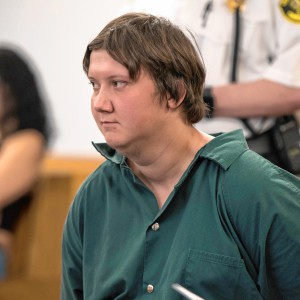Protesters ask PVTA to bolster routes, not cut them
| Published: 07-19-2017 7:26 PM |
SPRINGFIELD — They came with a simple message for Pioneer Valley Transit Authority: Give us more bus options, not less.
As the PVTA’s advisory board prepared to meet Wednesday in Springfield, 16 people stood outside to protest proposed cuts to bus services throughout the region due to a budget shortfall of $1.4 million.
“What do we do when we’re under attack?” yelled a man with a megaphone outside the Pioneer Valley Planning Commission building.
“Stand up, fight back,” the rest of the protesters answered.
Most held signs with slogans such as “Stand up for riders” and “PVTA no cuts: We need more, not less.”
Office employees at the planning commission building hurried inside with their heads down and ignored the protesters as much as possible.
Many of the protesters, like others who have recently expressed opposition to the potential elimination and reduction of bus service, said they were concerned with how these changes would affect the livelihoods of low-income people in the area.
“People won’t be able to get to work, get to school, buy groceries or really live their lives at all,” said Eric Bauer, 37, who works for Jobs with Justice. “We want the state and the city to reconsider allocating their funds to help these communities.”
Article continues after...
Yesterday's Most Read Articles
Bauer said he estimated half a million people per year would be affected by the PVTA cuts as they stood before the meeting. He said he hoped there would be an opportunity at the meeting for protesters to have their say before the vote.
Changes had already been made to the proposal. The PVTA initially planned to cut eight routes and reduce service on more than a dozen others.
But even with the amendments, some protesters said the policy, if passed, would not be acceptable.
“We need more bus service, not less,” said Holly Richardson, 52, from Florence. “Any cuts are too many cuts. Surely we can find a way to fill the gap without resorting to this.”
People from low-income areas, students and seniors are all populations that would be in trouble if bus service is cut, Richardson said.
Jaeden Frankhauser, a 14-year-old from Springfield, said he was protesting on behalf of his grandmother, who he said uses the buses to get everywhere she needs to go.
“She would have to walk everywhere, and I’m not sure how much longer she’ll want or be able to do that,” Frankhauser said. “I hope if we can talk about enough people like her who need them, they’ll vote against the cuts.”
Within half an hour, even the small group of protesters had attracted negative attention from those who worked in the building. A man ran outside and stood in front of the group.
“I hate to be a pain, but people work here, and your group and your loudspeaker are interrupting things,” he said. “You can stand over there on the sidewalk, but you can’t stay right here in front of the building. You don’t need to use the loudspeaker, please. We’re getting complaints, you can move over there.”
Some of the protesters simply left the premises instead. But others took it as their cue to enter the building to go to the meeting in the hopes of changing the minds of the advisory board.
“I think our values are seriously skewed,” Mark Dorsey, from Springfield, said as he walked inside. “People need these buses. Somebody has to care about that.”

 William Strickland, a longtime civil rights activist, scholar and friend of Malcolm X, has died
William Strickland, a longtime civil rights activist, scholar and friend of Malcolm X, has died Advancing water treatment: UMass startup Elateq Inc. wins state grant to deploy new technology
Advancing water treatment: UMass startup Elateq Inc. wins state grant to deploy new technology New Realtor Association CEO looks to work collaboratively to maximize housing options
New Realtor Association CEO looks to work collaboratively to maximize housing options Northampton man will go to trial on first-degree murder charge after plea agreement talks break down
Northampton man will go to trial on first-degree murder charge after plea agreement talks break down 
